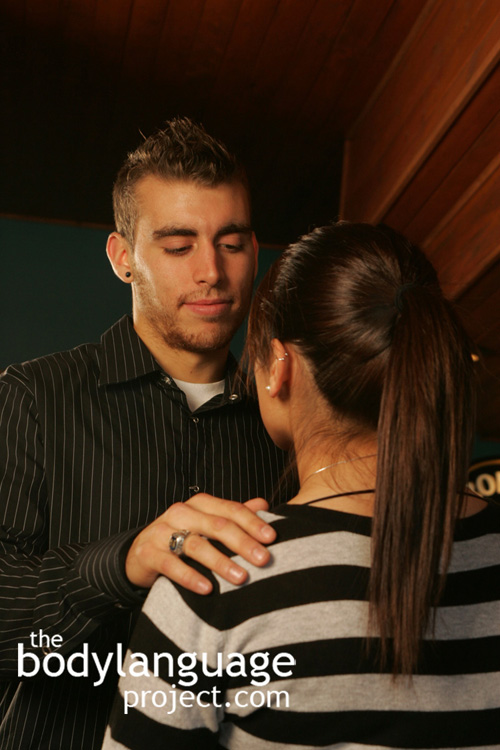Body Language of Palm Down Displays or Palm Power
Synonym(s): Palm Power, Palm Down On Desk, Fingertips Spread Palm Down On A Desk, Hands On Desk Or Table, Downward Facing Palm, Planted Fingertips.
Description: Hands are palm down, sometimes on a table, while speaking on a topic or issue.
In One Sentence: Palm down is a signal of authority.
How To Use it: Palms have very powerful powers. To wield them, simply display them palm down rather than palm up. Use the palms down on a desk while leaning the body forward. This shows other people that you are to be taken seriously. Use the palm-on-desk-lean-forward posture in negotiations or when trying to intimate such as in an interrogation. Placing the palms up and then down as a gesticulation against the top of the table is a way to showcase authority and the certainty of your held opinions.
Context: General.
Verbal Translation: a) “My palms are down with authority, there is no room for discussion here – just do as I say.” b) “What I say goes. I’m putting my palms down on the issue.”
Variant: See Palm Up Displays or The Rogatory Posture.
Cue In Action: a) The boss stood up, put his hands palm down on the boardroom desk, leaned in, and spoke slowly and deliberately. It was a message no one misunderstood for weakness, but rather high authority and dominance. b) To quiet the room, the speaker waved his hands at chest height, fingers slightly separated. He moved up and down to calm the audience as he prepared to speak.
Meaning and/or Motivation: Palms-up, palms-down and palms even all represent different things, from authority to submission.
The rule of thumb is that palms down “tell”, while palms up, “offer.”
Palm down shows dominance or superiority, palm up shows submissiveness and palm even equality. Palm down displays show emphatically that a position is held confidently.
When used with fingers closed, a palm down display is high authority – think of the Nazi salute.
Cue Cluster: Dominant cues are linked to palm down displays. Watch for palm down with fingertips spread to be accompanied by the body leaning in, head on, loud voice and slow dominant speech. Palm down is coupled with a loud, deep voice, arms spread apart, legs open or in the figure four, leaning back and showing confidence or leaning in with passion.
Body Language Category: Amplifier, Aggressive body language, Authoritative body language, Confident body language, Closed body language, Dominant body language, High confidence body language, Palm power, Power play.
Resources:
Alibali, M.W., Heath, D.C., and Myers,H.J. (2001). Effects of visibility between speaker and listener on gesture production: Some gestures are meant to be seen. Journal of Memory and Language, 44, 169–188.
Blurton Jones, N. G. (1967). “An Ethological Study of Some Aspects of Social Behaviour of Children in Nursery School.” In Desmond Morris (Ed.), Primate Ethology (Chicago: Aldine), pp. 347-68.
Brannigan, Christopher, and David Humphries (1972). “Human Non-Verbal Behaviour, A Means of Communication.” In N. G. Blurton-Jones, ed., Ethological Studies of Child Behaviour (Cambridge: University Press), pp. 37-64.
Bass, Andrew & Boris P. Chagnaud. 2013. Shared developmental and evolutionary origins for neural basis of vocal–acoustic and pectoral–gestural signaling. Proceedings of the National Academy of Sciences.
Birdwhistell, Ray. 1952. An introduction to kinesics. Louisville: University of Louisville.
Birdwhistell, Ray. 1970. Kinesics and context. Philadelphia: University of Pennsylvania.
Chaikin, Alan L. ; Gillen, Barry ; Derlega, Valerian J. ; Heinen, James R. K. ; Wilson, Midge. Students’ reactions to teachers’ physical attractiveness and nonverbal behavior: Two exploratory studies. Psychology in the Schools. 1978. 15(4): 588-595.
Carney, Dana R.; Amy J.C. Cuddy; Andy J. Yap. Power Posing: Brief Nonverbal Displays Affect Neuroendocrine Levels and Risk Tolerance. Psychological Science, 2010; 21 (10): 1363-1368.
Cuddy, Amy J.C., Caroline A. Wilmuth, and Dana R. Carney. The Benefit of Power Posing Before a High-Stakes Social Evaluation. Harvard Business School Working Paper, No. 13-027, September 2012.
Ekman, Paul & Wallace V. Friesen. 1972. Hand movements. Journal of Communication. Vol. 22, Dec. 1, pp. 353-374.
Engel, George. 1978. Clinical value of gestures, postures, and facial expressions. Public lecture. University of Washington. Seattle. December 5.
Ekman, Paul, and Wallace V. Friesen (1969). “Nonverbal Leakage and Clues to Deception.” In Psychiatry (Vol. 32), pp. 88-106.
Ferre, Gaelle. 2011. Functions of three open-palm hand gestures. Multimodal Communication, 2011, 1 (1), pp.5-20.
http://hal.archives-ouvertes.fr/docs/00/66/60/25/PDF/Multimodal-com-Ferre_final_.pdf
Friesen, Wallace ; Ekman, Paul ; Wallbott, Harald. Measuring hand movements. Journal of Nonverbal Behavior. 1979. 4(2): 97-112.
Fabrega, Horatio Jr. 1973. Begging in a southeastern Mexican city.” In Romney, A. K. & I. DeVore (eds.). You and others. Cambridge, Mass.: Winthrop, pp. 162-173.
Genthner, Robert W. ; Moughan, James Osipow, Samuel H. (editor). Introverts’ and extraverts’ responses to nonverbal attending behavior. Journal of Counseling Psychology. 1977. 24(2): 144-146.
Gorkan Ahmetoglu, Viren Swami. Do Women Prefer “Nice Guys?” The Effect Of Male Dominance Behavior On Women’s Ratings. Social Behavior And Personality, 2012; 40(4), 667-672.
http://bodylanguageproject.com/articles/how-to-significantly-increase-male-attractiveness-with-simple-body-language-nice-guys-finish-last-once-again/
Goffman, Erving. The Nature of Deference and Demeanor. American Anthropologist. 1956. 58(3): 473-502.
Givens, David B. (forthcoming). “Reading Palm-up Signs: Neurosemiotic Overview of a Common Hand Gesture” (Accepted for publication [March 4, 2015] in Semiotica).
Givens, David B. (1978A). “Social Expressivity During the First Year of Life.” In Sign Language Studies (20), pp. 251-274.
Givens, David B. (1978B). “Greeting a Stranger: Some Commonly Used Nonverbal Signals of Aversiveness.” In Semiotica (Vol. 22), pp. 351-67.
Givens, David B. 1977. Shoulder shrugging: A densely communicative expressive behavior. Semiotica. Vol. 19:1/2, pp. 13-28.
Givens, David B. 1982. An ethological approach to the study of human nonverbal communication. Ann Arbor: University Microfilms.
Givens, David B. 1986. The big and the small: Toward a paleontology of gesture. Sign Language Studies. No. 51. Summer, pp. 145-167.
Givens, David B. 2005. Love signals: A practical field guide to the body language of courtship. New York: St. Martin’s Press.
Givens, David B. 2014A. Nonverbal neurology: How the brain encodes and decodes wordless signs, signals, and cues. In Kostic, Aleksandra & Derek Chadee (eds.). Social psychology of nonverbal communication. New York: Palgrave-MacMillan Press, pp. 9-30.
Givens, David B. 2014B. Measuring gestures. In Kostic, Aleksandra & Derek Chadee (eds.). Social psychology of nonverbal communication. New York: Palgrave-MacMillan Press, pp. 66-91.
Grant, Ewan (1969). “Human Facial Expressions.” In Man (Vol. 4), pp. 525-36.
Goffman, Erving. 1956. The nature of deference and demeanor. American Anthropologist. Vol. 58, No, 3, June, pp. 473-502.
Goodall, Jane. 1986. The chimpanzees of gombe: Patterns of behavior. Cambridge: Belknap Press of Harvard University.
Givens, David B. (1982). “From Here to Eternity: Communicating With the Distant Future.” In Et Cetera (Vol. 39, No. 2), pp. 159-79.
Givens, David B. (forthcoming). “Reading Palm-up Signs: Neurosemiotic Overview of a Common Hand Gesture” (Accepted for publication [March 4, 2015] in Semiotica).
Hall, Karl & Irven DeVore. 1972. Baboon social behavior. In Phyllis Dolhinow (ed.). Primate patterns. San Francisco: Holt, Rinehart, and Winston, pp. 125-180.
Hubbard, Amy, McNealy, K., Zeeland, A., Callan, D. & M. Dapretto. 2012. Altered integration of speech and gesture in children with autism spectrum disorders. Brain and Behavior. Vol. 2, No. 5, Sept. 2012, pp. 606-619.
Iacoboni, Marco. 2009. Imitation, empathy, and mirror neurons. Annual Review of Psychology. Vol. 60, pp. 653-670.
Koppensteiner, Markus ; Grammer, Karl. Body movements of male and female speakers and their influence on perceptions of personality. Personality and Individual Differences. 2011. 51(6): 743-747.
Koppensteiner, Markus ; Stephan, Pia ; Jäschke, Johannes Paul Michael. From body motion to cheers: Speakers’ body movements as predictors of applause. Personality and Individual Differences. 2015. 74: 182-185.
Leigh, Thomas W. ; Summers, John O. An initial evaluation of industrial buyers’ impressions of salespersons’ nonverbal cues. Journal of Personal Selling & Sales Management. 2002. 22(1): 41(13).
Mehrabian, Albert ; Williams, Martin Mcguire, William J. (editor). Nonverbal concomitants of perceived and intended persuasiveness. Journal of Personality and Social Psychology. 1969. 13(1): 37-58.
Morris, Desmond (1994). Bodytalk: The Meaning of Human Gestures (New York: Crown Publishers).
Morris, Desmond (1994). Bodytalk: The Meaning of Human Gestures (New York: Crown Publishers).
Marler, Peter. 1965. Communication in monkeys and apes. In DeVore, I. (ed.), Primate behavior. New York: Holt, Rinehart & Winston, pp. 544-584.
McNeill, David. 1992. Hand and mind: What gestures reveal about thought. Chicago: University of Chicago Press.
McNeill, David. 2005. Gesture and thought. Chicago: University of Chicago Press.
Mittelberg, Irene. 2008. Peircean semiotics meets conceptual metaphor: Iconic modes in gestural representations of grammar. In Cienki, A. & C. Müller (eds.). Metaphor and gesture. Amsterdam/Philadelphia: John Benjamins, pp. 115-154.
Montgomery, Kimberly J., Isenberg, Nancy & James V. Haxby. 2007. Communicative hand gestures and object-directed hand movements activated the mirror neuron system. Social Cognitive and Affective Neuroscience. Vol. 2, No. 2, June, pp. 114-122.
Muller, C. 2004. Forms and uses of the palm up open hand: A case of gesture family?” In Muller, C. & Ronald Posner (eds.). The semantics and pragmatics of everyday gestures. Berlin: Weidler, pp. 233-356.
Norton, R. (1983). Communicator Style: Theory, Applications, and Measures (Beverly Hills: Sage Publications).
Navarro, Joe. 2008. What Every BODY is Saying: An Ex-FBI Agent’s Guide to Speed-Reading People. William Morrow Paperbacks.
Roll, William V. ; Schmidt, Lyle D. ; Kaul, Theodore J. Berdie, Ralph F. (editor). Perceived interviewer trustworthiness among black and white convicts. Journal of Counseling Psychology. 1972. 19(6): 537-541.
St J. Neill, S.R. The Effects of Facial Expression and Posture on Children’s Reported Responses to Teacher Nonverbal Communication. British Educational Research Journal. 1989. 15(2): 195-204.
Schubert, T. W. (2005). Your highness: Vertical positions as perceptual symbols of power. Journal of Personality and Social Psychology. 89. 1–21.
Trout, Deborah ; Rosenfeld, Howard. The effect of postural lean and body congruence on the judgment of psychotherapeutic rapport. Journal of Nonverbal Behavior. 1980. 4(3): 176-190.
Wiener, Morton ; Devoe, Shannon ; Rubinow, Stuart ; Geller, Jesse Mandler, George (editor). Nonverbal behavior and nonverbal communication. Psychological Review. 1972. 79(3): 185-214.
Waal, Frans De (1982). Chimpanzee Politics (London: Jonathan Cape).
Xu, Jiang, Gannon, Patrick J., Emmorey, Karen, Smith, Jason F. & Allen R. Braun. 2009. Symbolic gestures and spoken language are processed by a common neural system. Proceedings of the National Academy of Sciences.


